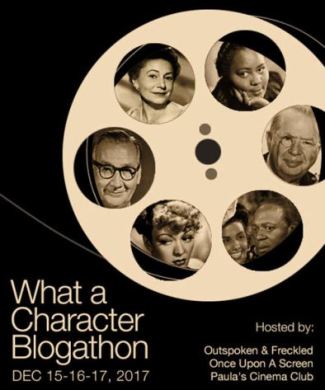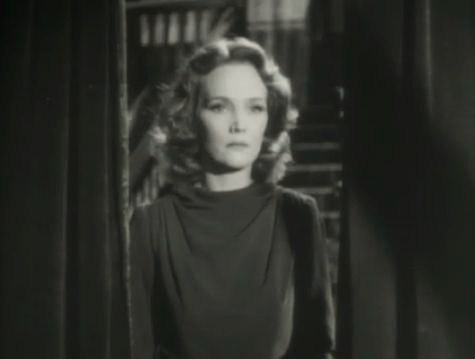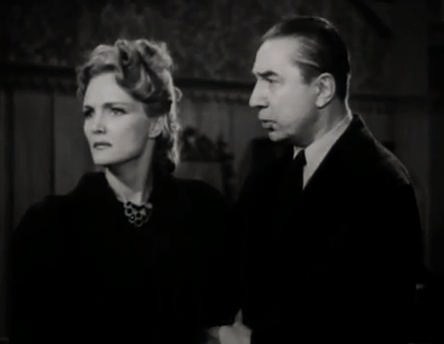
***This post is part of the Sixth Annual What a Character! Blogathon, hosted by the Outspoken & Freckled, the Paula’s Cinema Club, and the Once Upon A Screen blogs.***
***Some spoilers.***
“Russell often brought haughty imperviousness to mystical heights.” (biggayhorrorfan, par. 2)
I love character actors, especially classic film character actors. These are the people whose names you may not recognize on the end credits but whose faces are recognizable right away when you see them on screen. To me, the roles character actors and actresses play may be smaller but more unique and interesting.
The name Elizabeth Russell maybe vaguely familiar, that is, her last name, because she was the sister-in-law of an actress who certainly met the criteria of a star: Rosalind Russell. But her face is unforgettable when you see it for the first time – graceful, cat-like, strikingly beautiful, glamorous without even trying and capable of conveying different emotions, from diabolical evil to sassy energy to quiet sweetness.
Fans of the psychological horror films produced by Val Lewton will probably know Russell right away. I am a huge Val Lewton fan which is why I chose to write my blog post for this blogathon about Russell. Lewton was said to have been infatuated with her and even though there was never anything personal between them (according to The Very Witching Time of Night: Dark Alleys of Classic Horror Cinema by Gregory William Mank) but Lewton’s fascination led him to cast her in four of his films.
It was in fact in Lewton’s first film, Cat People (1942) that Russell first makes the impression that would stay with many audiences. In Mank’s words, “[t]he true star attraction [of the film] is Elizabeth Russell as the ‘Cat Woman’. Elizabeth’s zoomorphic vamp, in a killer black gown and with an ebony bow in her blond coiffure, will surely be one of Cat People’s top sensations” (pg. 231). The story of how she got the role is fairly uneventful:
“[W]riter Peter Viertel… mentioned that his friend Val Lewton was seeking a woman who looked like a cat for a film he was producing at RKO, and suggested Elizabeth go see him.” (Mank, p. 232)
Russell was less than thrilled that Viertel likened her appearance to a cat (she apparently was not fond of felines) although it’s clear his eye was accurate because Lewton cast her on the spot as the Cat Woman.
One of the noteworthy things about Russell’s performance in Cat People is that the one scene in which she appears is only a few minutes. In the film, Serbian Irena (played by another feline-like beauty, French actress Simone Simon) has just married a rather “golly-gee” kind of American, Oliver (Kent Smith) and they are celebrating with a modest reception in a Serbian restaurant. Russell’s scene is as follows:
“… as bride and groom laugh, the Cat Woman turns at her table, looks, rises, sashays over to the table, and poses for a haunting, spine-chilling but incredibly glamorous close-up… And the Cat Woman, having called Irena ‘my sister,’ elegantly places a fur over her shoulders – a nice bestial touch – and strolls out into the night and the snow.” (Mank, pg. 233)
The brief appearance of Russell is as memorable as her one-liner (she says “Moya Sestra” – which means “my sister” in Serbian – twice). The scene captures the dark shadows attached to the happy moment. As Mank points out, “Lewton loved mixing beauty and horror: in Elizabeth Russell, he had cast a beautiful woman who was strangely scary on screen” (pg. 233).

Photo Credit: Elizabeth Russell in Curse of the Cat People, 1944, cropped shot from the trailer, RKO: CecilF/ Wikimedia Commons/PD US no notice
This combination of beauty and horror that Russell seemed to capture so well made her a prefect candidate for future Lewton films. It’s no surprise, then, that he chose her for the sequel to Cat People: “Lewton [was] still infatuated with Elizabeth [and] cast her in the role that perhaps [fascinated] him most deeply” (Mank, pg. 242). The role was indeed fascinating, maybe the most fascinating of Russell’s career because it was her most complex emotionally. Russell plays a woman who lives isolated in a huge house with her mother Julia Farren (Julia Dean) who makes clear her loathing for her daughter and doesn’t hide her hostility toward her. This makes Russell’s character, Barbara Farren, reflect that hostility to the outside world with a general creepiness and unpleasantness. When she sees that her mother is warming up to Amy (Ann Carter), the lonely imaginative daughter of the now remarried Oliver, she becomes insanely jealous watching the child receive the love and kindness from Julia that she feels she deserves. As a Big Gay Horror Fan blog post states, “Curse of the Cat People… showed her off to vengeful effect…. [but] Russell provides moments of true heart, bringing out these characters’ inherent emotional agony” (biggayhorrorfan, par. 4). Her jealousy turns almost murderous at the end of the film but takes a sentimental turn where Barbara’s hands raised to the level of the child’s neck intent on strangling Amy wrap around the child in an embrace.
Russell’s roles in Lewton’s other films are quite small but memorable. In The Seventh Victim (1943), Russell has another tiny part with only a few appearances but again she leaves an impression. She plays Mimi, physically deteriorated from a physical illness (probably tuberculosis) who rents a room next to Jacqueline (Jean Brooks), the focus character in the film. Mimi “withers with cautious fear… [b]ut emerges from her shell” (biggayhorrorfilm, par. 5) at the end of the film. Three years later, Russell played another tiny role in Lewton’s Bedlam. Although the film is another psychological horror film, Russell’s role offers a surprisingly light tone. As the niece of one of the more evil characters, George Sims (played by Boris Karloff with his usual perfect balance of evil and elegance), Mistress Sims has an “arch sauciness” and “provides a number of comic interludes, easing the gravity of the film’s asylum based horror…” (biggayhorrorfilm, par. 6). This tongue-in-cheek wine-loving lady makes a nice contrast to Russell’s repertoire of insidious feline females.

Photo Credit: Elizabeth Russell and Bela Lugosi in The Corpse Vanishes, 1942, cropped screenshot, Monogram Pictures: CecilF/Wikimedia Commons/PD US not renewed
Although Russell’s haunting beauty did typecast her somewhat as in B-horror films (such as 1942’s The Corpse Vanishes with another classic horror actor, Bela Lugosi), she did break out now and then to do different roles. One of those was in the World War II drama Hitler’s Madmen (1943). Russell’s role in this film is the Everywoman, or rather, Peasant Everywoman who populated the villages of Nazi-occupied countries during the war. She is not frightening or evil in this film, but representative of the many victims of war who tried to live their lives under Nazi control. As Maria Bartonik, the wife of the resistant Czek farmer, Anton (Richard Bailey), her role is subtle and heartbreaking. The film is about the conflict between the “little people” resisting the Nazis versus those trying to get comply for the sake of survival. Maria embodies the dehumanization peasant women and mothers suffered at the hands of the Nazis. Russell’s reaction to her husband when he is delivered to her in a coffin is effective and subtle as she wordlessly watches the two peasant men carrying the coffin into the house and her immediate faint when they close the door behind them. In the climax of the film, when the townspeople are gathered to hear a chilling proclamation from the Nazis, we are privy to Maria’s reactions in the vast crowd of people, to her horror and fear and anger and we feel these emotions right along with her.
To end this post, I think an interesting story about Russell is in order. Mank tells of a screening of Curse of the Cat People in Baltimore in 1990 after which he was schedule to interview Russell for his book. Russell was seventy-four and had long retired from acting (the Internet Movie Database lists her last role in 1960). Yet, as she watched the final scene of the film, she suddenly ran out of the theater and into the sunlight as if she had been spooked by her own performance. Mank has his own interpretation of this incident:
“I believe the cause of Elizabeth’s response was due at least partly to how she was seeing herself – transfigured by Lewton, beautifully and chillingly representing the darkness that tortured him … becoming, in the climax of The Curse of the Cat People, the ‘wicked thing’ incarnate.” (par. 261; italics original)
I think this incident describes the kind of potent performance character actors can give in a film, even in their appearance is brief. Russell left her imprint on Lewton’s films and on other films as well (she became the model for the Mary Meredith painting that figures so prominently in the film The Uninvited in 1944). Russell’s feline looks and cool elegance makes her distinct not only in the B-horror films of the 1940’s but in other films as well.
Works Cited
biggayhorrorfan, “Unsung Femmes: The Corpse Vanishes’ Elizabeth Russell.” Web blog post. Big Gay Horror Fan. WordPress. 20 February 2014. Web. 13 December 2017.
Mank, Gregory William. The Very Witching Time of Night: Dark Alleys of Classic Horror Cinema. McFarland & Co., Inc., 2014. Kindle digital file.

It’s a testament to the indelibility of Russell’s work with Lewton that I was wracking my brain to remember who she was…until I read “Moya Sestra” in your title and I knew instantly. Thanks for this insight, I will watch these films more carefully now.
LikeLike
Hi Paula,
Thank you for your comment. Yep, Russell is definitely one of those “know by sight but not by name” character actors but she’s an interesting one.
Tam
LikeLike
It is through the Lewton films that I came to appreciate Elizabeth Russell, and gain a new appreciation for other actors. I appreciate the insights you provided in your article, and your choice of Ms. Russell for the blogathon.
LikeLike
Hi Patricia,
Thank you for your comments. I also came to appreciate Russell through the Lewton films although the other non-Lewton films I’ve seen with her have been memorable as well.
Tam
LikeLike
First, I had no idea Elizabeth Russell was Rosalind Russell’s sister-in-law.
Second, she really does have that eerie, almost ethereal quality in films like “Curse of the Cat People”. She was a perfect choice.
Third, thanks for all this biographical info. I really need to see more of her films, and “Hitler’s Madmen” is one I might try to track down first. Thanks!
LikeLike
Hi Silver Screenings,
Thank you for your comments. I also had no idea that Elizabeth was Rosalind Russell’s sister-in-law and that totally surprised me :-). I also want to see more of her films. I found “Hitler’s Madmen” and “The Corpse Vanishes” on YouTube and both are worth watching.
Tam
LikeLiked by 1 person